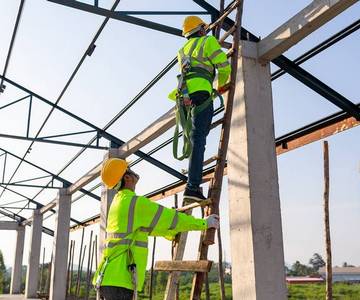
8 Best Workplace Ladder Safety Tips and Regulations

Every year, numerous deaths occur due to the result of ladder-related accidents. Thousands more have suffered from debilitating injuries while working on a ladder. As the employer, it is your responsibility to create a safe environment for working at heights. Many serious or fatal accidents can be avoided if the workplace ladder safety rules and regulations are followed.
Before climbing onto a ladder, ask whether this is necessary or if there is a safer and better alternative. Once a ladder is in use, following the safety guidelines will be critical. This will require caution, diligence, along with ladder safety online training and working at heights training for the workers. The professional training courses will teach employees about the safe use of ladders, along with other practical protocols.
Does your workplace require the use of ladders? Apply these ladder rules and regulations to your workplace safety plan:
1. Always inspect the workplace ladder safety.

Before a work shift, always inspect the ladder for any damages. Watch out for loose parts, bent steps, as well as natural wear and tear. Do not use damaged ladders until the appropriate repairs are done. You may need to inspect the ladder more regularly based on the type of ladder used. For example, fixed vertical ladders will demand more inspections than step ladders.
Print out comprehensive guidelines to help with the ladder inspections. When defects are identified, promptly report these problems and have them fixed to prevent potential injuries. Part of the inspection process involves placing the ladder on a stable surface. Uneven terrains are a common cause of ladder injuries, so make sure you clear away any hazards before beginning the work.
2. Wear the right shoes before climbing the ladder.

Workers need to get rid of the oil, grease, and mud off their shoes before using a ladder. For additional workplace safety and prevention, check the soles of the shoes to confirm they are free of debris. Sometimes, you may find screws and nails stuck to the bottom of your shoes, which will interfere with your climbing ability. Also, avoid leather shoes altogether because the material does not have good slip resistance.
3. Keep your hands free when climbing the ladder.

When climbing a ladder, employees should never carry up equipment and tools by hand. Instead, transport these items with a tethering system or a tool belt. Your hands are essential for gripping onto the ladder and helping you to maintain a safe balance. By keeping your hands free, you will have a lot more control when manoeuvring on the ladder.
Whether you are going up or down a ladder, the climber should always be facing it. There must always be three points of contact between the ladder and the climber. What this means is that the worker should either have two feet and one hand on the ladder, or two hands and one foot on the steps. This position promotes the best stability to reduce slips and falls.
4. Do not overreach when using the ladder.

Overreaching is the most common safety error in ladder accidents. Whenever you move your shoulder past the middle line of the ladder, this is considered overreaching. Try your best to avoid this bad habit. You may be in a hurry to climb up the ladder to complete your work, but you also risk throwing yourself off-balance. Instead, move up the ladder at a cautious and measured pace.
5. Make sure the ladder is suitable for you.

Is your ladder too short for the task at hand? Never try to add vertical height to the ladder by stacking it on top of other items, because these surfaces are not stable. Instead, workers should request for a longer ladder, one that allows them to reach their target comfortably. To ensure workplace ladder safety, employees should not attempt to work at heights until they have access to an appropriate ladder.
6. Be mindful of step ladder safety.

Step ladders are intended for single-person use. These types of ladders come in different sizes, usually ranging from 4 feet to 20 feet. Make sure the step ladder is placed securely with all four of its feet touching a flat level surface. You should never climb a step ladder while it is leaning against a wall, because this position is not completely stable.
When climbing a step ladder, workers should never go a step higher than the second from the top. Those top steps are not meant for climbing or standing. In addition, keep in mind that the rungs (located at the back of the step ladder) are not actual steps. The rungs cannot support a person’s weight and should not be climbed upon.
7. Adhere to extension ladder safety.

Extension ladders come in various designs, and each has its own set of limitations. As a rule of thumb, extension ladders should always stretch three feet beyond the building’s top ledge. For every four feet of elevation, make sure the ladder’s base is one foot away from the wall. That means if a ladder is extending against a twenty-foot wall, the base should be five feet from the wall.
Typically, two workers are needed to properly set up the ladder. Make sure you position it away from nearby obstacles, because many injuries occur when the ladders get snagged on a tree branch. Also, avoid setting up the extension ladder in unsafe weather conditions. You do not want to be caught by a strong gust of wind.
8. Train employees on workplace ladder safety.

As the employer, ensure the employees are trained on how to use a ladder. Health and safety training courses can inform employees on fall prevention awareness. They should think ahead to prevent interactions with anything that may impair the ladder’s stability. Make sure your staff understands the ladder rules and regulations to avoid dangerous practices in the workplace.

